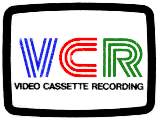Video Cassette Recording
 |
|
| Media type | Video recording media |
|---|---|
| Developed by | Philips |
| Usage | Home video, Educational use |
Video Cassette Recording (VCR) is an early domestic analog recording format designed by Philips. It was the first successful consumer-level home videocassette recorder (VCR) system. Later variants included the VCR-LP and Super Video (SVR) formats.
The VCR format was introduced in 1972, just after the Sony U-matic format in 1971. Although at first glance the two might appear to have been competing formats, they were aimed at very different markets. After failing as a consumer format, U-matic was marketed as a professional television production format, whilst VCR was targeted particularly at educational but also domestic users. Unlike some other early formats such as Cartrivision, the VCR format does record a high-quality video signal without resorting to Skip field.
Home video systems had previously been available, but they were open-reel systems (most notably made by Sony) and were expensive to both buy and operate. They were also unreliable and often only recorded in black and white such as the EIAJ-1. The VCR system was easy to use and recorded in colour but was still expensive: when it was introduced in 1972 the N1500 recorder cost nearly UK £600 (equivalent to £3,400 in 2016). By comparison, a small car (the Morris Mini) could be purchased for just over £600.
The VCR format used large square cassettes with 2 co-axial reels, one on top of the other, containing half inch (12.7 mm) wide chrome dioxide magnetic tape. Three playing times were available: 30, 45 and 60 minutes. The 60-minute videocassettes proved very unreliable, suffering numerous snags and breakages due to the very thin 17μm video tape. Tapes of 45 minutes or less contained 20 μm thickness tape. The mechanically complicated recorders themselves also proved somewhat unreliable. One particularly common failing occurred should tape slack develop within the cassette; the tape from the top (takeup) spool may droop into the path of the bottom (supply) spool and become entangled in it if rewind was selected. The cassette would then completely jam and require dismantling to clear the problem, and the tape would then be creased and damaged.
...
Wikipedia
